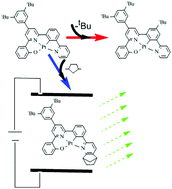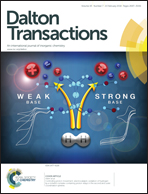The reasons for ligand-dependent quantum yields and spectroscopic properties of platinum(ii) complexes based on tetradentate O^N^C^N ligands: a DFT and TD-DFT study†
Abstract
DFT and TD-DFT methods have been employed to theoretically investigate the properties of three recently synthesized green-emitting platinum(II) complexes (1–3) bearing tetradentate O^N^C^N ligands (O^C^N^C = 2-(4-(3,5-di-tert-butylphenyl)-6-(3-(pyridin-2-yl)phenyl)-pyridin-2-yl)phenolate and its derivatives) that have been testified to be good emitters in organic light-emitting diodes (OLEDs), especially for complex 3. The effect of the variation of the substituents on the electronic and optical properties is emphatically explored. Our calculation results reveal that the introduction of an electron-releasing group on one phenyl ring of the O^C^N^C ligand (complex 2) does not result in a distinct alteration of the spectra. However, the incorporation of the norbornane group to the O^C^N^C ligand (complex 3) leads to a blue-shift in the absorption and emission spectra as compared with 1. In addition, how the absorption and emission spectra are affected by the solvent polarity is studied. Both the absorption and the emission spectra display red-shifts of various degrees with the decrease of the solvent polarity. The different phosphorescent quantum yields of the three complexes are compared. It is reasonable to believe that the high 3MLCT (metal-to-ligand charge transfer) contribution and high percentage of the metallic character (Mc, %) in the emission process, as well as the largest vertical transition energy for 3, result in the highest quantum efficiency.


 Please wait while we load your content...
Please wait while we load your content...